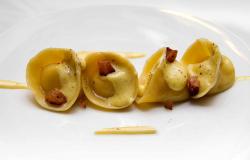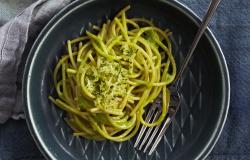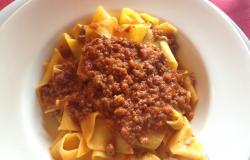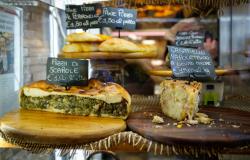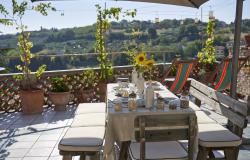Pane Arabo: Tuscany’s Unique Pizza Sandwich
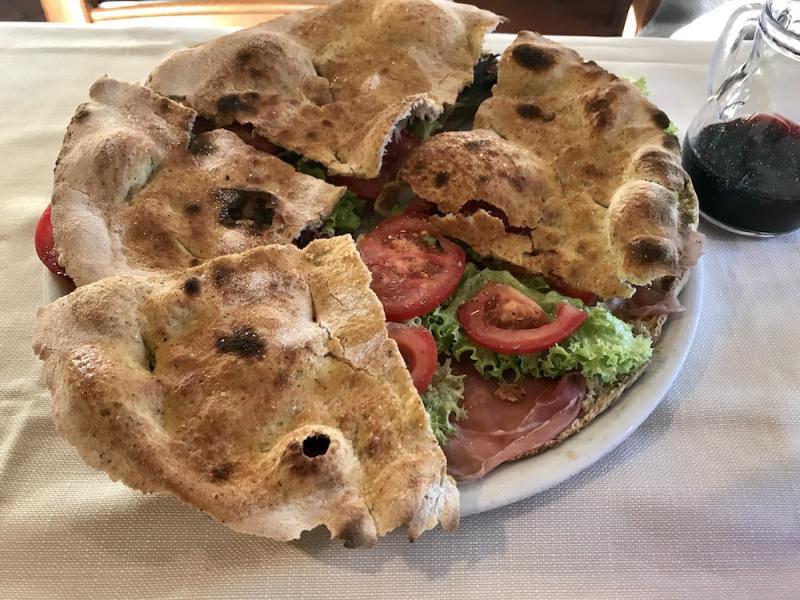
Pane Arabo, in Italian literally “Arab bread,” usually refers to some sort of pita. However, in Tuscany, they’ve taken the concept of “pita” to an entire new level. There, especially in the beach resort area of La Versilia, it’s a pizza sandwich of sorts. Plain pizza dough is baked, then split lengthwise and filled with prosciutto, lettuce and tomatoes. Interestingly, the filling never varies. On pizzeria and restaurant menus all along the Tuscan coast, pane arabo, is always and only listed as filled with prosciutto, lettuce and tomatoes.
Of course, the best is made with quality DOP prosciutto like Prosciutto Toscano, Prosciutto di Parma or Prosciutto San Daniele, flavorful crisp quality lettuce and vine-ripened tomatoes, but the key to this dish is the pizza dough.
You can recreate pane arabo made with store-bought dough, but the secret to the positively addictive earthy flavor of the one served at La Cantina da Bruno https://www.lacantinadabruno.com/---a favorite spot with locals in the Tuscan beach resort town of Camaiore---is the special combination of flours it uses in its dough, a mix of 00, whole wheat and buckwheat flour. Gianni, who along with his sister Anna Lisa, represents the second generation of this restaurant founded in 1963 by their dad and mom, Bruno and Rosetta Poli, have been serving pane arabo there for 50 years. The only change is the dough. It was Gianni, who while traveling in Puglia a few years ago, discovered grano arso, literally “burnt grain,” that region’s unique flour. In the past, after the harvest, Puglia’s wealthy landowners would grant the poor access to their fields so they could glean the grain, which had now been burned by the 19thmachines used to harvest them the fields. This ancient practice is, thankfully no longer necessary, but the deeply flavorful grano arso flour is still prized in Puglia and is recreated in roasting ovens. Nowadays it isn’t burned, so there’s no bitter aftertaste as in the past, but instead is slow roasted so has an intense smoky aroma with notes of barley and toasted hazelnuts. It’s worth seeking out online or in a specialty gourmet shop!
Serves 2
On a clean work surface or in a huge bowl, put the flour into a pile and made a well in the center. Put the yeast and 1/2 cup of the water in the center of the well, stir, and let rest until the yeast bubbles, about 3 minutes. Incorporate a little of the flour into the liquid to form a paste. Add the olive oil, sugar and salt, and taking a little flour at a time, slowly incorporate the flour and remaining water, until you’ve incorporated all the water. You might have a little flour left over, leave it on the side.
Knead the dough until it is smooth and elastic, at least 5 to 8 minutes. Roll into a ball, put into a lightly oiled deep bowl, cover with plastic wrap, and let rest for 1 1/2 hours, while it rises.
Meanwhile, lightly dust two flat cookie sheets or two flat baking pans about 12-inch by 16-inch with semolina flour or cornmeal. Of course, if you have a pizza stone or pizza baking tiles, then you’ll use those instead. But no worries if you don’t have special equipment. Preheat the oven to 500 degrees and set 2 racks on the lower third of the oven.
Divide the dough in two. Roll each section into a ball. Cover one ball with a damp cotton dishcloth as you work with the other ball.
Put the dough onto a lightly floured surface, preferably a large wooden cutting board. The idea is to make the round ball become thin round pizza dough by pressing from the center out with your palms and then your finger tips at first. Then, holding the pizza in place in the center with your palm, gently stretch the sides out and press them down with your palm until you have a large 1/2 inch disc. Put the dough onto one of the prepared baking sheets, drizzle with a little olive oil, prick with a fork all over the dough, and immediately put it into the oven, so it can bake while you work on the second ball of dough. Repeat with the other dough ball.
Bake the piazzas for about 8 minutes, then turn the pans, 180 degrees, so the pizzas cook evenly and bake them for another 8 to 10 minutes or until golden brown and cooked through.
Slice the pizzas horizontally, so you have a top and bottom section. Line with thin slices of prosciutto, then top with lettuce and tomato slices. Season to taste with dried oregano, salt and pepper. Close the “sandwich” and drizzle the top with a bit of olive oil. Cut into quarters and serve immediately.
Recipe courtesy of La Cantina da Bruno https://www.lacantinadabruno.com/
Via Italica, 6, Camaiore, Italy. Reservations highly recommended +39 0584 67624
*NOTE: if you’d like to recreate the amazing dough recipe from La Cantina, use only 1 ½ cups pizza flour and instead substitute ½ cup whole wheat flour, 1/4 cup buckwheat flour and 3/4 cups grano arso
